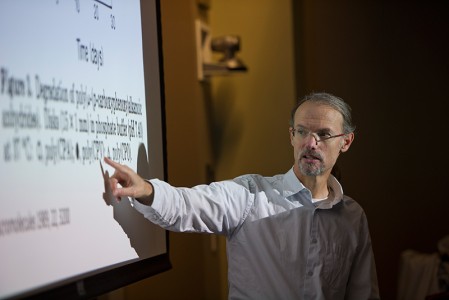Cancer Treatment Goes Local

Written By: Sara Elizabeth Cody | Source: BU Research
When it comes to treating cancer, one Boston University researcher is going local. Mark Grinstaff, a BU College of Engineering professor of biomedical engineering and materials science and engineering, published two studies in January 2016 that offer new approaches to the treatment of two intractable cancers—mesothelioma and esophageal cancer—by delivering therapeutic agents directly to the tumor site.
“Local drug delivery allows us to maximize drug dose at the disease site while reducing drug exposure to the rest of the body,” says Grinstaff, who is also a professor of chemistry and of medicine. “This approach affords significantly fewer negative side effects, like hair loss and an overall decrease in the immune system, which are common with conventional intravenous chemotherapy treatments.”
The first study, published in Scientific Reports, describes a highly targeted approach to treating mesothelioma, an aggressive and highly fatal cancer associated with asbestos exposure. Mesothelioma progresses locally, Grinstaff noted, and current chemotherapy treatments—which infuse toxic drugs throughout the body for a relatively brief period—have not been effective in extending survival.
Postdoctoral research associate Aaron Colby (ENG’09, ’14) prepared 100-nanometer particles that were small enough to enter a cancer cell, but expanded to 1,000 nanometers once exposed to the cell’s low pH level. In addition, the nanoparticles were engineered to attract a chemotherapy drug and draw it away from healthy cells through a process similar to that which causes oil to separate from vinegar. With the particles acting as beacons for the chemotherapy and the cancer cells unable to expel them quickly, the drug spent more time on target while avoiding healthy tissue.
“In our strategy, we are sending in a nanoparticle first and the drug second, which we have found to increase the amount of drug delivered to the tumor itself compared to the current treatment method,” says Colby.
The second study, published in Angewandte Chemie International Edition, reports a novel drug delivery technology to treat esophageal cancer. A common problem that arises with esophageal cancer patients is difficulty swallowing, as a result of the tumor narrowing or blocking the esophagus. Doctors insert a wire mesh stent to open the passageway.
Grinstaff and his research team had the idea to integrate drug delivery with this tool as a one-two punch to focus the drug on the problem itself. Graduate student Julia Wang wrapped a drug-infused polymer sheath around the stent so that when it is stretched, it releases drug directly to the disease site.
“By changing the treatment method from a more passive release system to a more active release system, we are able to control when and how much drug is released,” says Wang.
“What is unique about this drug delivery system is that the amount of drug delivered depends on the extent the cloth is stretched. Using this approach a clinician can tune the dose, something they cannot do today,” says Grinstaff. “That control comes from the polymer composition and the engineering aspects of the design.”
Grinstaff and his team continue to refine the technology so it can pass through the regulatory process and get into the clinics. According to Grinstaff, his unique approaches to treating these diseases will not only lead to more effective treatment, but also will reduce the exposure of healthy cells to toxic chemotherapy drugs.
“Above all else, the potential benefit of both studies is the impact on patient care,” says Grinstaff. “By improving upon and streamlining the processes in place to treat aggressive diseases that currently have poor prognoses and no good therapies, not only are you going to treat the disease itself more effectively, but you will also improve the patient’s quality of life.”